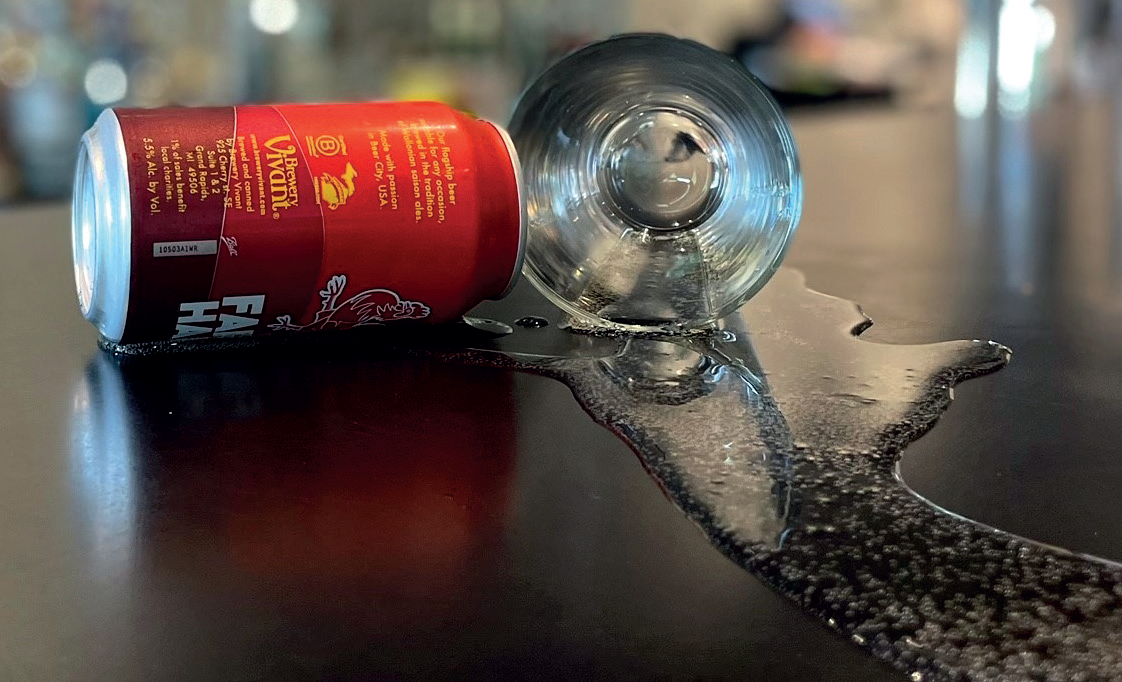Accidental, undesirable, costly, consequential, and unintended are all adjectives that can be used to describe spilled beer, but these same descriptors apply to fugitive emissions, and for that reason, fugitive emissions are very much the industrial valve equivalent of spilling a beer.
By Chad Pilbeam – Contributor
Anyone who has ever attended a beer festival is familiar with the sound of someone dropping their beer-sampling glass. What is comical for the attendees, is not so much so for the ‘pour’ soul (pun intended) who must go stand in line to get another beer and face the ridicule from surrounding peers. Sadness settles in as they watch the glass falling helplessly to the ground, and at the moment when those within earshot hear the hollow sound of glassware striking the floor, the mob offers collective harassment in the form of a cynical cheer, “HEYYYYY!”
Accidental, undesirable, costly, consequential, and unintended are all adjectives that can be used to describe spilled beer, but these same descriptors apply to fugitive emissions, and for that reason, fugitive emissions are very much the industrial valve equivalent of spilling a beer. Inversely, a spilled beer could be considered a fugitive beer; it is the beer that through unintended means, undesirably escaped.
Perhaps the best association is that there is an inherently negative connotation to the word ‘fugitive’, and no one can conjure up happy thoughts when hearing the word ‘spill’. These terms represent something negative and are yet another example of Beer Logic being applied – “Everything I ever needed to know about Industrial Valves, I learned from beer.”™
The Rise of Fugitive Emissions
To the informed industrial valve professional who is responsible for purchasing, installing, and maintaining valves, fugitive emissions are not a new concept. It is a coincidence that the industrial revolution that led to significant manufacturing applications in North America, is also the same period when the brewing industry experienced unprecedented growth. The oldest brewery in Canada is Molson, founded in 1786. The oldest brewery in the United States, founded in 1829, is Yuengling. By the late 1800s, the period of the Industrial Revolution, there were over 2,000 breweries in the United States. Canadian data was not easy to discern, but during this period the government forced the shutdown of 75% of the breweries to curb the consumption of intoxicating beverages. Through inductive reasoning, one can presume there was significant growth in the brewing industry which led to this decision.
Prohibition gave an unintended and undesirable ‘spilling of beer’ by the federal government (in both the US and Canada). While this was not accidental, rather it was quite intentional and anticipated, there were consequences. The investment in the industrial revolution also produced a consequence, the consequence of fugitive emissions, which increased significantly during the 1950s.
Manufacturing and home development required a significant increase in the need for more heat, and the new inventions and conveniences of the era required additional electricity. The result was a significant increase in fugitive emissions. These fugitive emissions continued to grow, and today it is estimated that they are five times greater than they were in the 1950s. It would be interesting to compare statistics about beer spillage in the 1950s, but since spilling beer has significantly less government regulation and environmental impact, such data does not exist. Despite the absence of statistical comparison, ‘fugitive beer’ is very much a real thing.
A spill in industrial applications is noticeable and can be addressed. Fugitive emissions differ in that they are less noticeable and often undetectable, hence the name ‘fugitive’. When thinking of spilled beer, images emerge of broken bottles, dropped cans, or tipped-over glass; these are spills. ‘Fugitive beer,’ like fugitive emissions, can come in other forms. Improperly seated couplers, worn gaskets, loose faucets, and unbalanced tap systems (wrong CO2 pressure and temperature) are all forms of ‘fugitive beer’. ‘Fugitive beer’ comes on the packaging line as well, from overfills, leaks in the connections, and low-fill cans that cannot be sold and must be destroyed. None of these ‘fugitives’, whether they be from industrial applications or the beer industry, are intended or desirable. The results are higher costs, reduced efficiency and productivity, and environmental consequences (breweries have been fined and shut down for their environmental impact as well).

Mitigating Emissions
As a means of controlling costs and reducing risk in the workplace, leak detection is an imperative maintenance measure to adhere to in both brewing and industrial applications. The proverbial fight with any maintenance program is always cost, which is typically represented in service fees or labor, and the materials and tools to perform the maintenance. This cost is often weighed against the expense of neglect, failure, and repair.
Frankly, it is the ‘Bean Counter’ analogy of comparing the cost of maintenance against the cost of ignorance and choosing to not be aware of potential fugitive emissions; this same battle exists in taprooms and bars when calculating the cost of maintaining a draft beer system. Fortunately, the math has already been done on this subject and it is widely accepted and endorsed, that a comprehensive leak detection and repair program (LDAR) is the best method to control costs, maintain efficiency, and mitigate potential consequences associated with fugitive emissions.
The math was done for bar managers too. Lines that are maintained properly every two weeks not only provide better-tasting beer but also reduce ‘fugitive beer’. Couplers are cleaned and reseated. Gaskets are checked. Fittings, clamps, and faucets are all tightened to ensure drops of beer are not lost.
Partners and technology are available to support both industries in reducing fugitives. Whether in-house or outsourced, LDAR expertise and technology exist. Industrial valve professionals cannot ignore that valves account for over 60% of fugitive emissions; this is compared to 15% from pumps and 10% from holding tanks. The impact is significant and growing, but so are the mandates to reduce fugitive emissions.
The data support an investment in a comprehensive LDAR program as well as technology such as intelligent valve positioners and remote sensors. There is no reason to withhold these investments. They will eventually be a requirement, meaning that the implementation of these measures today is an investment in the future.
Additionally, it is estimated that a well-implemented LDAR program can reduce fugitive emissions by as much as 90%.
Consider the Effects
Little drops of beer eventually fill a pint glass. Draft beer experts have set the performance metric of 95% efficiency for a keg of beer in a ‘perfect application’. A standard 15.5 US Gallon keg holds 124 pints of beer. At 95% efficiency that is roughly 117 pints; a loss of seven pints from the keg is considered acceptable (and it should be noted that this loss usually comes in the form of spills at the tap or samples poured for customers).
A more realistic standard is 90%, or roughly 111 pints. Sadly, many taprooms do not have beer equivalent to LDAR and have an efficiency of 80% or less. Because the margin on draft beer is the highest of all beer sales in the bar, this 20% loss is often overlooked. However, 20% represents a loss of 24 pints. 24 pints at $6.00 USD each represents $144.00 USD in lost sales. If that tap is changed every 14 days, that is two kegs per month, resulting in one tap costing the bar $3,456.00 USD annually in lost sales. If there are 20 taps on the wall, this accounts for $69,120 USD in lost sales from ‘fugitive beer’. With this data-supported analogy, can the cost of fugitive emissions from valves be calculated? Rhetorical, and it supports an LDAR.
Fugitive emissions account for 5% of all global greenhouse gas emissions. 5% may seem negligible compared to the collective factors accounting for the remaining 95%, but it is not insignificant. Just as a little foam from the tap might seem small, it too is not insignificant. To a keg of beer, foam is the primary enemy. A glass of foam is 25% beer, and it is estimated that over 90% of the keg loss is the result of too much foam produced by an unbalanced system.
An unbalanced system does not maintain the proper pressure from CO2 or the proper serving temperature. With this understanding and knowledge, taprooms are getting more sophisticated with their investments in smart technology that monitors pours, determines keg volume and potential sales, and helps regulate CO2 pressure and cooler temperature. By abandoning outdated practices, implementing a comprehensive LDAR program (maintenance/ monitoring), and investing in technology, loss from ‘fugitive beer’ and fugitive emissions can be drastically reduced.
Final Thoughts
If the data, industry recommendations, and anecdotal information are not enough to motivate action to make significant investments in resources for an LDAR program, perhaps an emotional plea is in order. To a beer lover, spilling a beer, whether by accident or on purpose, is a sad event. One sees the beverage they love, spilled on the counter or floor and they think to themselves, “I would have liked to drink that.”
A bad beer is poured down the drain and that represents money spent on something that was not enjoyed. A brewery or bar owner who walks into the taproom to see foam spewing from the tap, beer dripping from the line in the cooler, and kegs being returned with unsold beer in them, likewise sees profits leaving in the form of ‘fugitive beer’, which accumulate and can lead to the of closing the business.
If one looks at fugitive emissions with the same emotional lens, it might help us with implementing LDAR strategies. Objectively, we know the impact. Aside from empirical data, promoting a safer workplace and reducing environmental impact play an emotional role. Watching foam spill over in a pint glass from the tap represents beer that could have been enjoyed. Fugitive emissions are those that could have been captured. It is important to go beyond regulations and compliance and apply this emotional attachment to fugitive emissions for cost savings, productivity, safety, and the environment. And after you have applied your best efforts against fugitive emissions, have a pint. You earned it!



